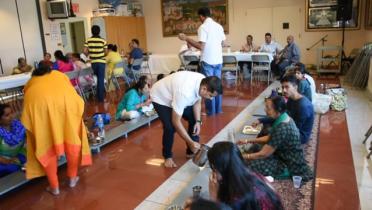Jain Tradition: Worship, Space, Ritual Objects, and Hymns
This notion that “all Jains are Gujaratis” is overshadowing the true representation of who Jains are and the religion Jainism. As part of Brooklyn Arts Council's Citizen Folklife initiative, Smrita Jain does fieldwork in order clear up this misconception.
As a child, my grandfather and grandmother would make me sit together every evening after school and study one of the main Jain books, called “Meri Bhawana”. The literal translation of these words is “My Intentions”, but it can also be interpreted as “My Actions” or “My Karma”. The book describes the path of righteous life one must lead to achieving salvation. The foundation of the Jain principles is always doing the right thing, at the right time and with the right intentions.
After visiting the Jain Center of America, I realized what I knew about Jainism was only the tip of the iceberg. There is a plethora of hymns, prayers and traditional objects ascribed with the Jain religion that I was not aware of. A collection of these at the Jain Center of America helped me get a better understanding of their use and intention in particular, and of the cultural importance they encompass in general.
Audio starts at 4:10 – This is Chandan puja. So, we have to do Chandan puja first. And then I do the pushp puja with flowers, then I do the dhoop, Deepak, Akshat means rice, Naived means sweet, and then phal any kind of fruit, and then after the morning procedure we do aarti, mangal devo. After that we do chakyavandan. So in the morning this procedure take almost one and a half hours. We do every single day. And now a days we have paryushan so we are celebrating a different way – takes a long time. Otherwise, generally people come around 12 o clock or 1 o clock but nowadays they are coming at 3 – 4 to do the puja. And then after we do anghi, downstairs you see right? Then we put it here on the Bhagwan and thereafter we do pratikrama in the evening. All day we do any kind of paath and then we hear the lecture when the scholars come India. They talk to us about the Jain religion. And then at night, again we do Mangal Aarti and then we go home.
All 24 tirthankars have 14 dreams always. And same dreams. This is all the symbols. So, the mothers of all tirthankars had the same 14 dreams always. Before bhagwan is born, the mother gets these 14 dreams and then the tirthankara is born immediately.
What is this made of?
This is all made of gold.
Real gold?
Yes. It’s silver from inside but is plated with real gold.
We have this kind of books. We call them kalpasutra. This is our whole Jain learnings. Everyone has to have this every paryushan. Everything about Jainishm is written in these granths.
Namokar Mantra
Namo Arihantanam
Namo Siddhanam
Namo Ariyanam
Namo Uvajhayanam
Namo loye sav sahunam
Aso panch namo karo sav paap nashno
Mangala nanche save singh paramam hawai Mangalam

